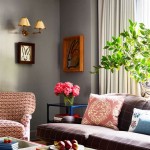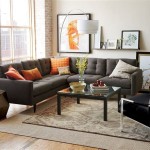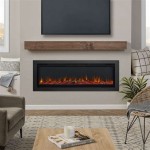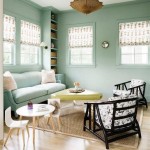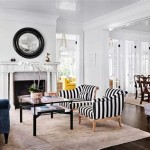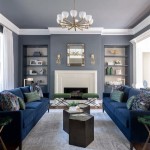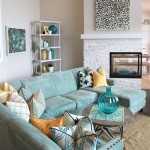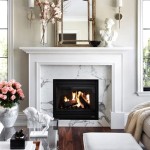Elevating the Living Room Aesthetic: Design Strategies Without a Fireplace
The fireplace, often considered the heart of the living room, serves as a natural focal point around which furniture is arranged and decorative elements are centered. However, many modern homes are constructed without fireplaces, presenting both a design challenge and an opportunity to reimagine the living room space. This article explores strategies for creating a visually appealing and functional living room environment in the absence of a traditional fireplace, focusing on alternative focal points, furniture arrangement, and decorative approaches.
Creating a Visual Focal Point
In the absence of a fireplace, establishing a clear focal point is crucial for grounding the room and guiding the eye. The focal point serves as a visual anchor, providing a sense of balance and structure to the space. Several alternatives can effectively fulfill this role, depending on the room's architecture, size, and intended use. The selection of a focal point is critical in establishing the design theme and overall ambiance in the living space.
One popular option is to designate a large piece of artwork as the focal point. A striking painting, a curated gallery wall, or a sculptural installation can draw attention and establish a distinct aesthetic. The size and style of the artwork should be proportionate to the wall and the room's overall dimensions to avoid overwhelming the space. The color palette and subject matter should complement the existing décor and reflect the homeowner's personal taste.
Another effective approach is to use a feature wall. This can be achieved through various means, such as applying a distinctive paint color, installing patterned wallpaper, or incorporating textured materials like wood paneling or stone veneer. A feature wall provides visual interest and depth, creating a dynamic backdrop for the furniture arrangement. The choice of materials should consider the room's lighting conditions and the desired level of visual impact. A dark-colored wall, for example, can create a more intimate and dramatic atmosphere, while a light-colored wall can enhance the sense of spaciousness.
A large window with a captivating view can also serve as a natural focal point. If the living room boasts expansive windows overlooking a garden, cityscape, or scenic landscape, the view itself becomes the primary focus. In such cases, the furniture arrangement should be oriented towards the window to maximize enjoyment of the view. Minimal window treatments can further enhance the connection to the outdoors, allowing natural light to flood the room and creating a sense of openness. If the view is not particularly attractive, strategic landscaping or the installation of decorative window film can improve the visual impact.
Media consoles or entertainment centers can also function as focal points, particularly in living rooms designed primarily for relaxation and entertainment. A well-designed media console can house the television, sound system, and other electronic devices while providing storage for media and accessories. The console's design should complement the room's overall aesthetic and be proportionate to the television screen size. Surrounding the media console with decorative elements, such as bookshelves, plants, or artwork, can further enhance its visual appeal.
Ultimately, the choice of focal point depends on the individual's preferences and the specific characteristics of the living room. Careful consideration should be given to the existing architecture, natural light, and intended use of the space to ensure that the focal point is both visually appealing and functionally appropriate.
Optimizing Furniture Arrangement
The arrangement of furniture is paramount in creating a functional and inviting living room space, especially in the absence of a fireplace. The layout should promote conversation, facilitate movement, and maximize the available space. Careful planning and consideration of the room's dimensions are essential for achieving a balanced and harmonious arrangement.
One common approach is to create a seating arrangement that encourages social interaction. This typically involves arranging sofas, chairs, and other seating elements around a central coffee table or ottoman. The seating should be positioned to allow for comfortable conversation and visual connection between occupants. The distance between seating elements should be carefully considered to ensure that individuals can easily communicate without having to strain their voices. A well-placed area rug can help to define the seating area and anchor the furniture grouping.
In smaller living rooms, maximizing space is a key consideration. Multifunctional furniture, such as sofa beds, storage ottomans, and nesting tables, can help to optimize the use of limited square footage. Wall-mounted shelves and cabinets can provide storage without taking up valuable floor space. Floating shelves can be used to display decorative items and books without adding visual clutter. Mirrors can also be strategically placed to create the illusion of greater space and reflect natural light.
In larger living rooms, it may be possible to create multiple seating areas, each serving a different purpose. For example, one area could be designated for formal conversation, while another could be used for relaxation and reading. Dividing the room into distinct zones can enhance its functionality and create a more versatile living space. Area rugs, furniture placement, and decorative elements can be used to visually separate the different zones.
Traffic flow is another important consideration when arranging furniture. Pathways should be clear and unobstructed, allowing for easy movement between different parts of the room. Furniture should be arranged to avoid creating bottlenecks or forcing individuals to navigate around obstacles. The placement of doorways and windows should also be taken into account to ensure that furniture does not block access or views.
The orientation of the furniture should also be considered in relation to the focal point. The seating arrangement should be directed towards the chosen focal point, whether it is a piece of artwork, a feature wall, or a window with a view. This helps to create a sense of balance and visual harmony within the room. The furniture arrangement should also take into account the available natural light. Positioning seating near windows can maximize exposure to sunlight and create a brighter and more inviting atmosphere.
Incorporating Decorative Elements
Decorative elements play a vital role in enhancing the aesthetic appeal of a living room without a fireplace, adding personality, texture, and visual interest to the space. The selection and placement of decorative items should complement the overall design theme and reflect the homeowner's individual style. Careful consideration should be given to color, texture, scale, and balance when incorporating decorative elements into the living room.
Textiles, such as throw pillows, blankets, and rugs, are an excellent way to add warmth, color, and texture to a living room. A variety of textures, such as velvet, linen, and wool, can create a sense of depth and visual interest. Throw pillows can be used to introduce pops of color and pattern to the seating arrangement. A well-chosen area rug can define the seating area and anchor the furniture grouping. The color and pattern of the textiles should coordinate with the overall color scheme of the room.
Plants and greenery can bring life and vitality to a living room, creating a sense of freshness and connection to nature. Potted plants, hanging baskets, and floral arrangements can be strategically placed throughout the room to add visual interest and purify the air. The selection of plants should consider the room's lighting conditions and the homeowner's level of gardening expertise. Low-maintenance plants, such as succulents and snake plants, are a good choice for individuals with busy lifestyles. Larger plants can be used to fill empty corners and create a more dramatic effect.
Lighting is a crucial element in creating a welcoming and functional living room environment. A combination of ambient, task, and accent lighting can create a layered and well-balanced lighting scheme. Ambient lighting, such as recessed lighting or a chandelier, provides overall illumination for the room. Task lighting, such as table lamps or floor lamps, provides focused light for reading or other activities. Accent lighting, such as spotlights or wall sconces, highlights specific features, such as artwork or architectural details. Dimmers can be used to adjust the lighting levels and create different moods.
Mirrors can be used to enhance the sense of space and reflect natural light. A large mirror placed on a wall can create the illusion of a larger room and brighten the space. Mirrors can also be used to reflect interesting architectural details or views. The placement of mirrors should be carefully considered to avoid creating unwanted reflections or glare.
Decorative objects, such as sculptures, vases, and candles, can add personality and visual interest to a living room. These items should be carefully curated to reflect the homeowner's personal style and complement the overall design theme. The scale and placement of the decorative objects should be considered to avoid creating clutter or overwhelming the space. Grouping objects together in vignettes can create a more visually appealing display.
Ultimately, the selection and placement of decorative elements should be guided by the homeowner's personal preferences and the desired aesthetic of the living room. Careful consideration of color, texture, scale, and balance is essential for creating a visually appealing and harmonious space.

How To Create A Living Room Focal Point No Fireplace Splat

How To Create A Living Room Focal Point No Fireplace Splat

How To Have A Cozy Living Room Without Fireplace Worthing Court Diy Home Decor Made Easy

How To Have A Cozy Living Room When You Don T Fireplace

Why A Focal Point Doesn T Always Need To Be Fireplace The Living House
Why A Focal Point Doesn T Always Need To Be Fireplace The Living House

12 Shapely Living Room Ideas No Fireplace

Interior Design Ideas Designer S Home

Coastal Inspired Home Renovation

House Home 10 Living Room Design Ideas You Ll Love

